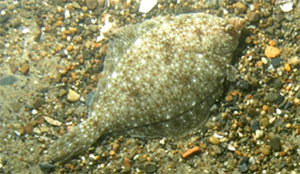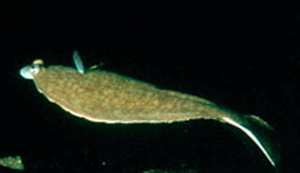
Yellowtail flounder live on the ocean floor and especially prefer sandy bottoms.
High resolution (Credit: NOAA)
N.O.A.A. will take several steps that may help minimize the economic loss for commercial fishermen who face cuts in Georges Bank fishery quotas, which are jointly fished and managed with Canada. One particular stock, Georges Bank yellowtail flounder, is a mid-value fish often caught incidentally while fishermen target high value stocks like cod, haddock, and scallops.
Poor stock conditions have continued because fewer fish are growing to catchable size than previously expected. As a result, the overall U.S. allocation of the Georges Bank yellowtail flounder stock will be reduced by 61 percent this fishing year.
The U.S. yellowtail flounder allocation is divided between the scallop and groundfish fisheries. Yellowtail flounder are bycatch in the high value scallop fishery. Under existing regulations, the yellowtail flounder allocation to the scallop fishery will increase by 53 percent to approximately 679,024 pounds in 2012. The allocation to the groundfish industry, however, will be reduced by 80 percent to roughly 480,608 pounds.
"While this is good for the scallop industry, it's a challenge for the bigger and some of the smaller groundfish boats that go to Georges Bank," said Samuel Rauch, acting assistant administrator, N.O.A.A. Fisheries Service. "Several actions that we already have in the works may help mitigate some of these impacts."

Yellowtail flounder are a thin-bodied flatfish. Both of its eyes are on the right side of its body.
High resolution (Credit: NOAA)
N.O.A.A. actions that may help mitigate economic loss
N.O.A.A. has just approved management project revisions giving N.O.A.A. the authority to reallocate any projected unused portion of the scallop fishery's Georges Bank yellowtail flounder allocation to groundfish fishing vessels.
These new management measures also authorize mid-sized fishing vessels to use a new type of trawl fishing gear that may enable fishers to reduce their bycatch of yellowtail flounder while they target other groundfish species.
N.O.A.A. and the New England Fishery Management Council, through the scallop research set-aside plan and other N.O.A.A. Cooperative Research Plan funds, will support several new research plans in 2012 aimed at reducing yellowtail bycatch on Georges Bank and in other areas.
Backing is expected to be awarded to the University of Massachusetts School of Science and Technology, to the Coonamessett Farm Foundation, Incorporated in collaboration with the Virginia Institute of Marine Science, and to the Gulf of Maine Research Institute for 3 separate projects, all designed to provide real time information to help fishermen avoid yellowtail and maximize their fishing opportunity on abundant target species.
Last week, N.O.A.A. and the council also announced the formation of a new working group, modeled after the successful Gulf of Maine Cod Working Group that projects to work closely with the fishing industry to explore how to advance these current initiatives and to identify other ideas and management alternatives that may ease the impact of the new regulations on the fishing industry.
The situation with yellowtail flounder could be worse, were it not for legislation introduced by Congressman Barney Frank and Senator Olympia Snowe in 2010, supported by the entire Northeast delegation, and enacted in January 2011. The International Fisheries Arrangement Clarification Act allowed N.O.A.A. in 2011 to extend the rebuilding timeframe for these shared stocks. The Georges Bank yellowtail flounder rebuilding timeframe was extended from 2016 to 2032, enabling larger allocations. Even with the extended rebuilding schedule, N.O.A.A. and the industry are faced with this big reduction in 2012.
NOAA's mission is to understand and predict changes in the Earth's environment, from the depths of the ocean to the surface of the sun, and to conserve and manage our coastal and marine resources. Join us on Facebook , Twitter and our other social media channels.

